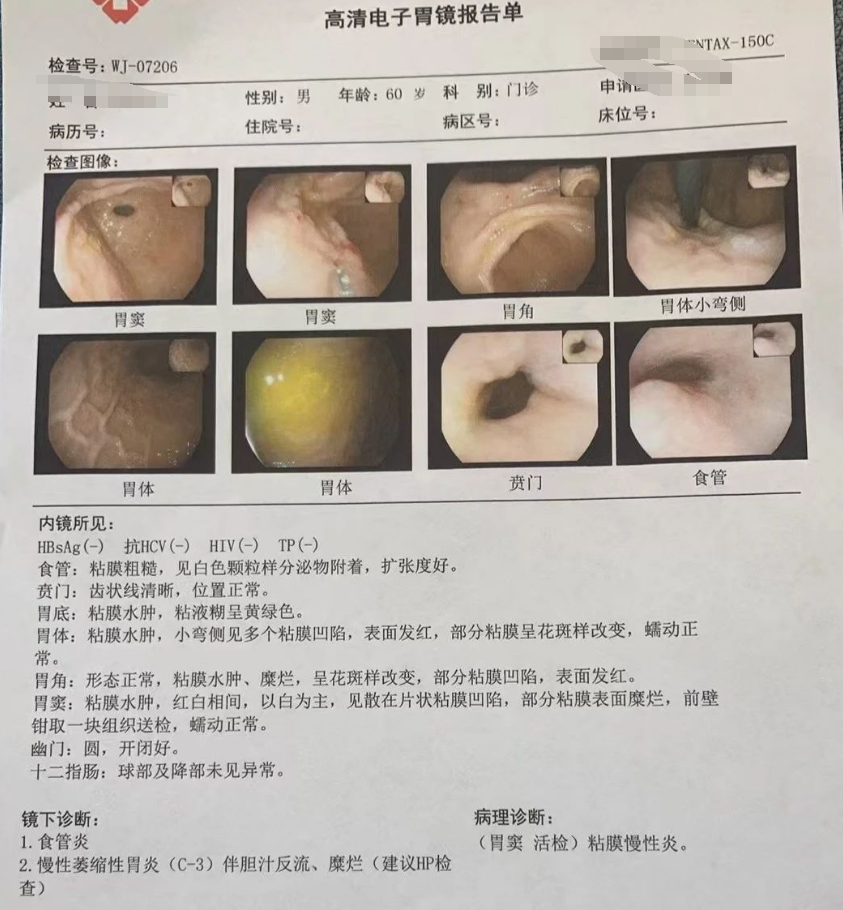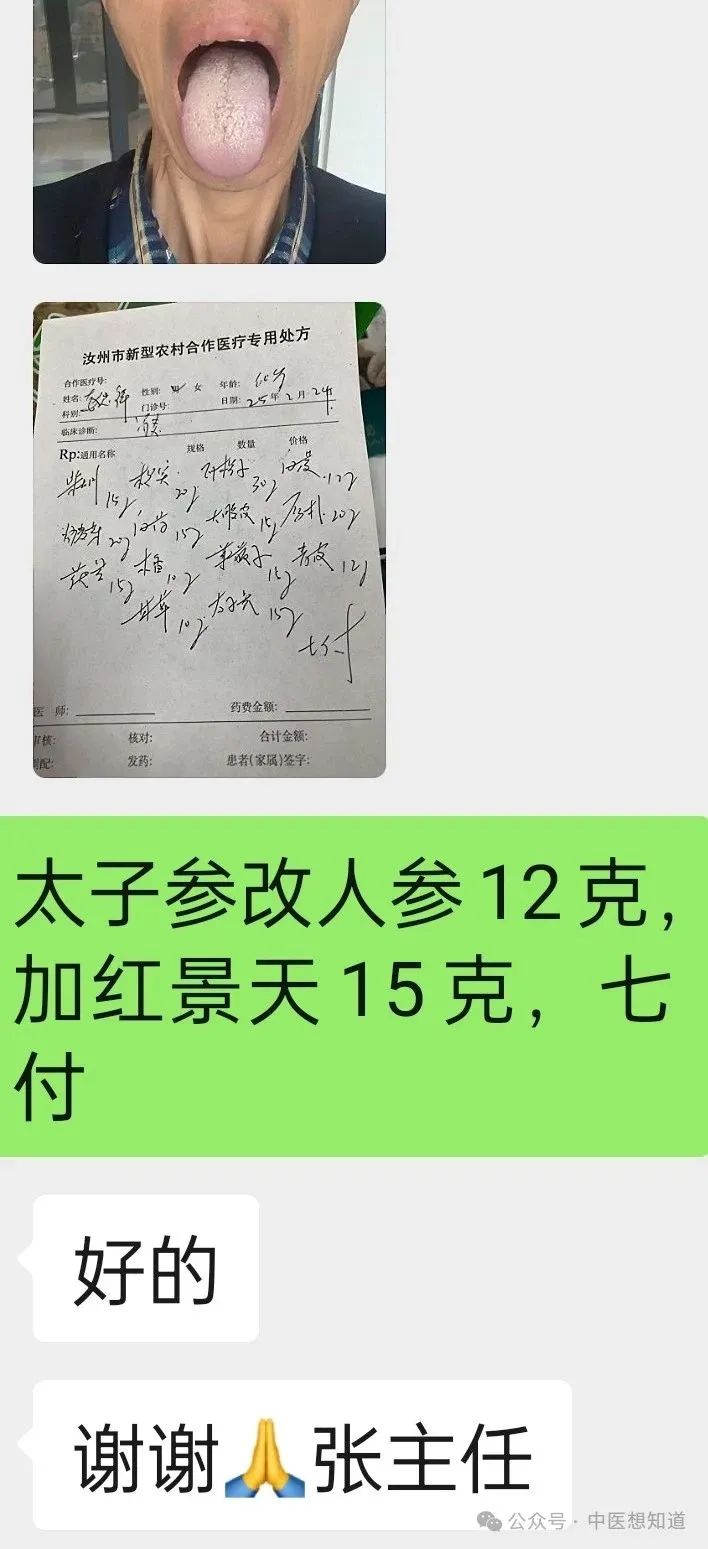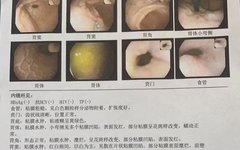A case of atrophic gastritisMale, 60 years oldAtrophic gastritis, presenting with abdominal distension, belching, acid reflux, poor appetite, and fatigue. Gastroscopy: bile reflux esophagitis, atrophic gastritis, erosion, intestinal metaplasia. After seeing renowned TCM masters and experts for several years, the condition worsened.After 24 years of treatment, significant improvement was noted. In November, I went out of town, and he could not find me for a consultation. After a follow-up in January, he contacted me, but it was too far for me to see him. The follow-up results were as above, with symptoms as described.First consultation: Prescribed the above formula for seven doses, with symptoms basically disappearing and appetite greatly improved, though he still felt slightly fatigued and lacked energy.Second consultation: The formula was modified from Tai Zi Shen (Codonopsis) to Ren Shen (Ginseng), adding Hong Jing Tian (Rhodiola) for seven doses.Prescription details are as follows:
 First consultation prescription:Chai Hu (Bupleurum) 15g, Zhi Shi (Bitter Orange) 20g, Wa Leng Zi (Citrus) 30g, Bai Ji (Bletilla) 12gChao Mai Ya (Barley Sprout) 20g, Bai Shao (White Peony) 15g, Da Fu Pi (Areca Peel) 15g, Hou Po (Magnolia Bark) 20gFu Ling (Poria) 15g, Mu Xiang (Aucklandia) 10g, Lai Fu Zi (Radish Seed) 15g, Qing Pi (Green Tangerine Peel) 12gGan Cao (Licorice) 10g, Tai Zi Shen (Codonopsis) 15g, total of 7 doses.Second consultation prescription:Chai Hu (Bupleurum) 15g, Zhi Shi (Bitter Orange) 20g, Wa Leng Zi (Citrus) 30g, Bai Ji (Bletilla) 12gChao Mai Ya (Barley Sprout) 20g, Bai Shao (White Peony) 15g, Da Fu Pi (Areca Peel) 15g, Hou Po (Magnolia Bark) 20gFu Ling (Poria) 15g, Mu Xiang (Aucklandia) 10g, Lai Fu Zi (Radish Seed) 15g, Qing Pi (Green Tangerine Peel) 12gGan Cao (Licorice) 10g, Ren Shen (Ginseng) 12g, Hong Jing Tian (Rhodiola) 15g, total of 7 doses.Analysis and explanation of the case:
First consultation prescription:Chai Hu (Bupleurum) 15g, Zhi Shi (Bitter Orange) 20g, Wa Leng Zi (Citrus) 30g, Bai Ji (Bletilla) 12gChao Mai Ya (Barley Sprout) 20g, Bai Shao (White Peony) 15g, Da Fu Pi (Areca Peel) 15g, Hou Po (Magnolia Bark) 20gFu Ling (Poria) 15g, Mu Xiang (Aucklandia) 10g, Lai Fu Zi (Radish Seed) 15g, Qing Pi (Green Tangerine Peel) 12gGan Cao (Licorice) 10g, Tai Zi Shen (Codonopsis) 15g, total of 7 doses.Second consultation prescription:Chai Hu (Bupleurum) 15g, Zhi Shi (Bitter Orange) 20g, Wa Leng Zi (Citrus) 30g, Bai Ji (Bletilla) 12gChao Mai Ya (Barley Sprout) 20g, Bai Shao (White Peony) 15g, Da Fu Pi (Areca Peel) 15g, Hou Po (Magnolia Bark) 20gFu Ling (Poria) 15g, Mu Xiang (Aucklandia) 10g, Lai Fu Zi (Radish Seed) 15g, Qing Pi (Green Tangerine Peel) 12gGan Cao (Licorice) 10g, Ren Shen (Ginseng) 12g, Hong Jing Tian (Rhodiola) 15g, total of 7 doses.Analysis and explanation of the case:
This case reflects the organic integration of Ye Tianshi’s “Liver and Stomach Treatment” philosophy and the Menghe School’s “Harmonizing the Middle Jiao” characteristics. The analysis is layered from theory to practice:
1. Pathogenesis Analysis (from Ye Tianshi’s perspective on collateral diseases)
1. Liver Qi rebellion against the Stomach, bile turbidity rising
Belching, acid reflux, bile reflux → Ye Tianshi states, “The liver is the source of the disease, and the stomach is the place of transmission” (Clinical Guidelines for Medical Cases)
Ye Tianshi states, “The liver is the source of the disease, and the stomach is the place of transmission.” The patient’s abdominal distension, belching, and acid reflux all belong to the pattern of wood stagnation and earth obstruction. Ye Tianshi states, “The liver is the source of the disease, and the stomach is the place of transmission.” The patient’s abdominal distension, belching, and acid reflux all belong to the pattern of wood stagnation and earth obstruction.
Chai Hu (Bupleurum) and Qing Pi (Green Tangerine Peel) soothe and benefit the liver and gallbladder, aligning with Ye’s principle of “treating the stomach must assist in draining the liver”.
2. Long-term illness entering the collaterals, stomach membrane losing nourishment
Atrophy and intestinal metaplasia belong to “stomach collaterals obstruction”. Ye states, “In the early stages, Qi stagnation is in the meridians; in long-term illness, blood injury enters the collaterals.” Atrophic gastritis with intestinal metaplasia belongs to “stomach yin desiccation”, but this case primarily features Qi deficiency, hence the use of ginseng to tonify Qi and generate fluids.
Bai Ji (Bletilla) protects the membrane and promotes tissue regeneration, subtly aligning with Ye’s idea of “unblocking and tonifying the stomach collaterals”.
3. Spleen and Stomach Qi deficiency, ascending and descending functions impaired
Abdominal distension, poor appetite, fatigue → Menghe School’s Fei Boxiong states, “Middle deficiency leads to stagnation, causing calamity”.
Replacing Tai Zi Shen (Codonopsis) with Ren Shen (Ginseng) reflects Ma Peizhi’s principle that “when deficiency is severe, one should strongly tonify the original Qi”.
2. Treatment Principles:
Soothe the liver and harmonize the stomach: Following Ye Tianshi’s principle, “to awaken the stomach, one must first control the liver”, Chai Hu (Bupleurum) and Qing Pi (Green Tangerine Peel) soothe the liver, while Bai Shao (White Peony) nourishes the liver.
Unblock and descend Yangming: Menghe’s Fei Boxiong skillfully employs the “unblocking and descending method”; Da Fu Pi (Areca Peel), Hou Po (Magnolia Bark), and Lai Fu Zi (Radish Seed) work together to descend Qi.
Simultaneous tonification and purging: Tai Zi Shen (Codonopsis)/Ren Shen (Ginseng) solidify the foundation, paired with Qi-regulating herbs to prevent obstruction, reflecting Menghe’s “light and harmonious” characteristics.
3. Prescription Analysis (Characteristics of Menghe School’s Medication)
First consultation formula (soothe the liver and harmonize the stomach, simultaneous tonification and purging)
Soothe the liver and relieve stagnation: Chai Hu (Bupleurum) 15g, Bai Shao (White Peony) 15g, Qing Pi (Green Tangerine Peel) 12g; Fei Shengfu states, “To treat the liver, one must use the same harmonization”, using Chai Hu to soothe the liver and Bai Shao to nourish the liver.
Descend rebellious Qi and protect the membrane: Wa Leng Zi (Citrus) 30g, Bai Ji (Bletilla) 12g; Ding Ganren skillfully uses Wa Leng Zi to control acidity, aligning with modern gastroscopy micro-differentiation.
Move the spleen and eliminate distension: Hou Po (Magnolia Bark) 20g, Da Fu Pi (Areca Peel) 15g, Mu Xiang (Aucklandia) 10g, Lai Fu Zi (Radish Seed) 15g; Ma Peizhi states, “Tonification and purging should proceed together”, using a heavier dose of Hou Po to achieve “broadening the intestines and descending Qi”.
Strengthen the center and generate fluids: Tai Zi Shen (Codonopsis) 15g, Fu Ling (Poria) 15g, Gan Cao (Licorice) 10g; Fei Boxiong states, “Nourish the upright and gradually plan”, with Tai Zi Shen being sweet and mild to prevent obstruction.
Second consultation formula (tonify Qi and raise Yang, solidify the foundation and prevent changes)
Ren Shen (Ginseng) replaces Tai Zi Shen (Codonopsis): Ma Wenzhi states, “When deficiency is severe, one should strongly tonify the original Qi”, with Ren Shen greatly tonifying the Qi of the spleen and lungs.
Adding Hong Jing Tian (Rhodiola) 15g: Integrating Menghe’s “light can eliminate the solid” with Ye Tianshi’s collateral disease theory, it aims to “tonify Qi, unblock the collaterals, and improve gastric mucosal microcirculation”.
4. Ye Tianshi’s Treatment Method Origins
1. Spicy and moistening method for unblocking collaterals
In the formula, Chai Hu (Bupleurum) is paired with Bai Shao (White Peony), subtly aligning with Ye’s principle that “the liver should be soothed, and the liver body should be moistened” (Unpublished Ye’s Medical Cases).
2. Unblocking and tonifying Yangming method
Bai Ji (Bletilla) combined with Chao Mai Ya (Barley Sprout) reflects Ye’s idea that “when the stomach is deficient, it should be unblocked and tonified, not just tonified” (Clinical Guidelines for Medical Cases – Spleen and Stomach).
3. Ascending and descending interdependence method
Chai Hu (Bupleurum) ascends the clear, while Lai Fu Zi (Radish Seed) descends the turbid, restoring the pivot of the spleen and stomach’s ascending and descending functions.
5. Characteristics of the Menghe School
1. Pure and gentle
The entire formula contains no extreme cold or heat herbs; Fei Boxiong states, “The most bland is the most miraculous” (Medical Purity and Remaining Meaning).
2. Separate treatment of the spleen and stomach
Fu Ling (Poria) strengthens the spleen and drains dampness, while Chao Mai Ya (Barley Sprout) awakens the stomach and aids digestion, reflecting Menghe’s idea of “the spleen ascends and the stomach descends”.
3. Skillful use of paired herbs
Mu Xiang (Aucklandia) paired with Lai Fu Zi (Radish Seed): specifically effective for moving Qi and eliminating distension.
Hou Po (Magnolia Bark) combined with Da Fu Pi (Areca Peel): effectively broadens the middle and eliminates fullness.
6. Clinical Application Guidance
(1) Key points for staged treatment
Acute phase: Soothe the liver and descend rebellious Qi, Chai Hu (Bupleurum) 15g, Wa Leng Zi (Citrus) 30g, Qing Pi (Green Tangerine Peel) 12g; stop when the disease is moderate to prevent excessive drainage.
Relief phase: Strengthen the spleen and harmonize the collaterals, Ren Shen (Ginseng) 12g, Hong Jing Tian (Rhodiola) 15g, Bai Ji (Bletilla) 12g; gradually reduce Qi-regulating herbs and increase nourishing yin products.
Consolidation phase: Nourish the kidney and stomach, adding Gou Qi Zi (Goji Berries) 15g, Shi Hu (Dendrobium) 12g, E Zhu (Curcuma) 6g; prevent intestinal metaplasia and consider adding anti-cancer herbs!
(2) Additions and subtractions based on symptoms
1. Significant yin deficiency: add Ye Tianshi’s commonly used herbs, Bei Sha Shen (North American Ginseng) 15g, Mai Dong (Ophiopogon) 12g (sweet, cool, moistening).
2. Significant blood stasis: add Menghe School’s Dan Shen (Salvia) 20g, Tan Xiang (Sandalwood) 6g (treating Qi and blood together).
3. Damp-heat not cleared: combine Fei Shengfu’s experience with Pu Gong Ying (Dandelion) 30g, Yi Yi Ren (Job’s Tears) 30g (clearing and transforming damp-heat).
(3) Extension of characteristic therapies
1. Paste therapy (Menghe School’s characteristic)
Base formula: Ren Shen (Ginseng) 100g, Hong Jing Tian (Rhodiola) 150g, San Qi (Notoginseng) 60g, E Zhu (Curcuma) 60g, honey to make a paste.
Dosage: 1 spoon each morning and evening, dissolved in warm water.
2. External treatment (Ye Tianshi’s experience)
Wu Zhu Yu (Evodia) 30g, Chai Hu (Bupleurum) 60g, powdered and mixed with vinegar to apply to the Zhongwan (Middle Cavity) and Gan Shu (Liver Shu) points.
7. Modern Research Support
1. Inhibition of intestinal metaplasia mechanisms
Hong Jing Tian (Rhodiola) glycosides can downregulate the NF-κB pathway, delaying precancerous gastric lesions (J Ethnopharmacol. 2021).
2. Regulation of bile reflux
Chai Hu (Bupleurum) and Bai Shao (White Peony) can coordinate the movement of the Oddi sphincter (World J Gastroenterol. 2019).
3. Improvement of mucosal atrophy
Ren Shen (Ginseng) saponin Rg3 promotes the proliferation of gastric epithelial cells (Phytomedicine. 2020).
Conclusion
This case integrates Ye Tianshi’s “regulating the liver and harmonizing the stomach, unblocking and tonifying the collaterals” with the Menghe School’s “pure and gentle, separate treatment of the spleen and stomach” academic essence. Clinical practice must grasp:
1. Emphasis on symptomatic treatment: Soothe the liver, benefit the gallbladder, and descend rebellious Qi.
2. Emphasis on root treatment: Strengthen the spleen, benefit Qi, and nourish the stomach collaterals.
3. Emphasis on prevention of changes: Activate blood, unblock collaterals, and prevent minor issues from escalating.
As Menghe’s master Ding Ganren stated, “To treat chronic gastric diseases, it should be like spring rain, nourishing without sound.” It is recommended that subsequent treatments consider adding E Zhu (Curcuma), Bai Hua She She Cao (Hedyotis) and other anti-cancer herbs, along with long-term regulation using paste therapy.

Thanks to Teacher Zhang Litiao for the authorization. We hope to bring support to everyone’s journey in TCM through the serialization of the teacher’s speeches and manuscripts.
You may also like, click to read the original text:Learning TCM only requires one image!XU Wenbing: Understanding TCM requires self-awareness and consciousness to gain wisdom.//////////–End–1000 sets of TCM books#Introduction to TCM #TCM Notes #Meridians#TCM Common Knowledge#TCM Popular Science #TCM Clinical Observation

